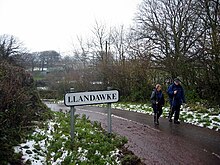
Carmarthen Bay is an inlet of the South Wales coast, including notable beaches such as Pendine Sands and Cefn Sidan sands. Carmarthen Bay is partially within the Pembrokeshire Coast National Park. The Joint Nature Conservation Committee list Carmarthen Bay and Estuaries as a Special Area of Conservation.

Laugharne is a town on the south coast of Carmarthenshire, Wales, lying on the estuary of the River Tâf.

Carmarthen West and South Pembrokeshire was a constituency of the House of Commons of the Parliament of the United Kingdom. It elected one Member of Parliament (MP) by the first past the post system of election.
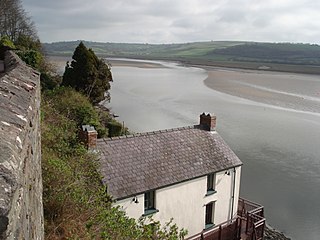
The River Taf is a river in West Wales. It rises in the Preseli Hills, Pembrokeshire, and continues through Carmarthenshire to Laugharne. It is one of the three rivers to enter the sea on the east side of Carmarthen Bay. The other two are the River Gwendraeth and River Tywi.

The River Gwendraeth is a river in Carmarthenshire in West Wales.
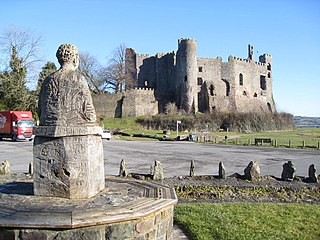
Laugharne Castle is in Laugharne, Carmarthenshire, Wales. The castle, located on the estuary of the River Tâf, was originally established in 1116. It was rebuilt as a Norman stronghold. There have been many alterations since then, including becoming a Tudor fortified manor house in the sixteenth century. It changed hands twice during the English Civil War, being eventually captured by Parliamentary forces in 1644.
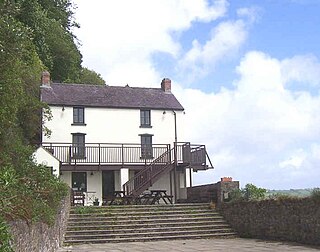
The Boathouse in Laugharne, Wales, was where Dylan Thomas lived with his family during his last four years between 1949 and 1953. The house is set in a cliff overlooking the Tâf estuary and is where he wrote many of his major pieces. It has been suggested that he wrote Under Milk Wood here but more recent research suggests that fewer than 300 lines of the play were written in Laugharne.

Llanddowror is a village and community in Carmarthenshire, Wales situated 2 miles (3 km) from St. Clears. Previously on the trunk road to Pembroke Dock, the village is small, historic and relatively unspoilt.

Carmarthen West and South Pembrokeshire is a constituency of the Senedd. It elects one Member of the Senedd by the first past the post method of election. In addition, it is one of eight constituencies in the Mid and West Wales electoral region, which elects four additional members, in addition to eight constituency members, to produce a degree of proportional representation for the region as a whole.

Cantref Gwarthaf was the largest of the seven cantrefi of Dyfed in southwest Wales. It subsequently became part of Deheubarth in around 950. It consisted of the southeastern part of Dyfed containing most of the basin of the River Tâf, parts of modern-day Pembrokeshire and Carmarthenshire.

Llangynog is a village and community located in Carmarthenshire, Wales, the main settlement of which was once called ‘Ebenezer’village. It is bordered by the communities of: Newchurch and Merthyr; Carmarthen; Llangain; Llansteffan; Laugharne Township; and St Clears, all being in Carmarthenshire. The population at the 2011 census was 492.

Castle House in Laugharne, Carmarthenshire, Wales, is a Grade II*–listed Georgian mansion. Described by Dylan Thomas as “the best of houses in the best of places”, it is one of many buildings of note in the medieval township.
Coygan Cave was an ossiferous cave near Laugharne in Carmarthenshire, Wales. The cave was about a mile from the sea and located in a limestone hillside, but has been destroyed by quarrying.
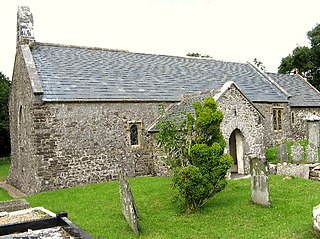
The Church of St Margaret Marloes is the Church in Wales parish church for the parish of Eglwyscummin, in southwestern Carmarthenshire, Wales. The present building dates from the 14th and 15th centuries with restoration work being undertaken in 1878 and again in 1900. The church has a round churchyard, an indication that this site has likely been used since prehistoric times. A tombstone dating back to the fifth century was found in the churchyard. It is believed that Saint Cynin founded the church as one of a series of missionary stations in the fifth century.
The first election to the Carmarthen Rural District Council in Carmarthenshire, Wales was held in December 1894. It was followed by the 1898 election. The successful candidates were also elected to the Carmarthen Board of Guardians. In rural parishes, many councillors were returned unopposed.
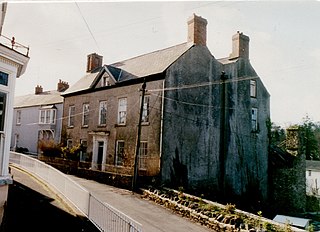
The Great House in Laugharne, Carmarthenshire, Wales, is a Grade II*–listed early eighteenth century gentry residence in the Queen Anne style and is one of many buildings of note in the medieval township. The property was originally built with a central 'dog-leg' passage to the Double Pile plan with gable chimneys under two saddle roofs. Its interesting features include two carved round arches to the landing at first floor level, a small inset square-headed window to the central gable and an exceptional Baroque doorcase. The history of the house and that of its surroundings up to 1878 was chronicled by Mary Curtis.

Island House is a Grade II* listed, partly Tudor, sub-medieval townhouse located in Laugharne, Carmarthenshire, in southwest Wales. It sits below the castle between the two mouths by which the River Corran enters the Tâf estuary, known locally as "Earth Lake" and "Mill Orange". The frontage now ranges along Wogan Street but was formerly set in a walled garden. Built principally of stone, the earliest parts date from the 15th century, with additions from the 16th and 19th centuries. The grading status signifies a building of exceptional interest and it is the oldest residence in the township. The historic importance of whole site is shown by separate listings of its garden, walls and outbuildings.
Laugharne Township is the name of an electoral ward for Carmarthenshire County Council in Carmarthenshire, Wales. It is represented by one county councillor.
Glanamman is the name of an electoral ward for Carmarthenshire County Council, in the Amman Valley, Carmarthenshire, Wales. It is represented by one county councillor.
